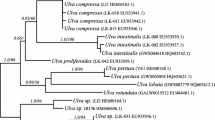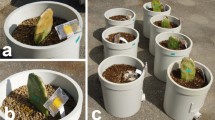Summary
Thickness, relative water content (RWC), osmotic pressure, water potential isotherms, and mucopolysaccharide content were measured for the photosynthetic chlorenchyma and the water-storage parenchyma of the winter hardy cactus, Opuntia humifusa, after shifting from day/night air temperatures of 25° C/15° C to 5° C/−5° C. After 14 d at 5° C/−5° C, the average fraction of water contained in the symplast decreased from 0.92 to 0.78, the water potential of saturated (fully hydrated) tissue was essentially unchanged, but the osmotic pressure of saturated tissue decreased (by 0.15 MPa for the chlorenchyma and 0.12 MPa for the water-storage parenchyma). After 7 weeks at 5° C/−5° C, tissue thickness was reduced by 61% for the chlorenchyma and 65% for the water-storage parenchyma, and the RWC decreased by 42% and 68%, respectively; these changes contributed to an osmotic pressure increase of 0.55 MPa for the chlorenchyma and 0.34 MPa for the water-storage parenchyma. During the 7 week acclimation to low temperature, mucopolysaccharide increased by 114% for the chlorenchyma and by 89% for the water-storage parenchyma. The water potential of the extracted mucopolysaccharide was relatively constant for an RWC between 1.00 and 0.30, decreasing abruptly below 0.30. Changes in water relations parameters and in mucopolysaccharide content during low-temperature acclimation may reduce water efflux from the cells, and thus reduce damage due to rapid dehydration during extracellular freezing.
Similar content being viewed by others
References
Ashworth EN (1990) The formation and distribution of ice within Forsythia flower buds. Plant Physiol 92:718–725
Ashworth EN, Abeles FB (1984) The freezing behavior of water in small pores and the possible role in the freezing of plant tissues. Plant Physiol 76:201–204
Barcikowski W, Nobel PS (1984) Water relations of cacti during dessication: distribution of water in tissues. Bot Gaz 145:110–115
Benson L (1982) The cacti of the United States and Canada. Stanford University Press Stanford, CA
Chen P, Gusta LV (1978) The role of water in cold hardiness of winter cereals. In: PH Li, A Sakai, (eds) Plant cold hardiness and freezing stress. Academic Press, New York, pp 165–174
Franks F (1985) Biophysics and biochemistry at low temperatures. Cambridge University Press, Cambridge
Geiger R (1950) The climate near the ground. Harvard University Press, Cambridge, MA
Gibson AC, Nobel PS (1986) The cactus primer. Harvard University Press, Cambridge, MA
Goldstein G, Andrade JL, Nobel PS (1991) Differences in water relations parameters for the chlorenchyma and parenchyma of Opuntia ficus-indica under wet versus dry conditions. Aust J Plant Physiol 18:95–107
Guy CL (1990) Cold acclimation and freezing stress tolerance: role of protein metabolism. Annu Rev Plant Physiol Plant Mol Biol 41:187–223
Hansen J, Beck E (1988) Evidence for ideal and non-ideal equilibrium freezing of leaf water in frosthardy ivy (Hedera helix) and winter barley (Hordeum vulgare). Bot Acta 101:76–82
Hoagland DR, Arnon DI (1950) The water-culture method for growing plants without soil. Calif Agr Expt St Circ 347:1–32
Kindel PK, Liao S-Y, Liske MR, Olien CR (1989) Arabinoxylans from rye and wheat seed that interact with ice. Carbohydrate Res 187:173–185
Koch KE, Kennedy RA (1980) Effects of seasonal changes in the midwest on Crassulacean acid metabolism (CAM) in Opuntia humifusa Raf. Oecologia 45:390–395
Krog JO, Zachariassen KE, Larsen B, Smidsrod O (1979) Thermal buffering in Afro-Alpine plants due to nucleating agent-induced water freezing. Nature 282:300–301
Larcher W, Bauer H (1981) Ecological significance of resistance to low temperature. In: OL Lange, PS Nobel, CB Osmond, H Ziegler (eds) Physiological plant ecology I. Responses to the physical environment. Encyclopedia of plant physiology, NS, Vol 12A, Springer Berlin Heidelberg New York pp 403–438
Levitt J (1978) An overview of freezing injury and survival, and its interrelationships to other stresses. In: PH Li, A Sakai (eds) Plant cold hardiness and freezing stress. Academic Press, New York, pp 3–15
Littlejohn RO Jr, Williams GJ III (1983) Diurnal and seasonal variations in activity of Crassulacean acid metabolism and plant water status in a northern latitude population of Opuntia erinaceae. Oecologia 59:83–87
Lopez FB, Nobel PS (1991) Root hydraulic conductivity of two cactus species in relation to root age, temperature, and soil water status. J Exp Bot 42:143–149
McGarvie D, Parolis H (1981) The acid-labile, peripheral chains of the mucilage of Opuntia ficus-indica. Carbohydrate Res 94:57–65
Morse SR (1990) Water balance in Hemizonia luzulifolia: the role of extracellular polysaccharides. Plant Cell Environ 13:39–48
Nobel PS (1976) Water relations and photosynthesis of a desert CAM plant, Agave deserti. Plant Physiol 58:576–582
Nobel PS (1980a) Morphology, surface temperatures, and northern limits of columnar cacti in the Sonoran Desert. Ecology 61:1–7
Nobel PS (1980b) Influences of minimum stem temperatures on ranges of cacti in southwestern United States and central Chile. Oecologia 47:10–15
Nobel PS (1981) Influence of freezing temperatures on a cactus, Coryphantha vivipara. Oecologia 48:194–198
Nobel PS (1982) Low-temperature tolerance and cold hardening of cacti. Ecology 63:1650–1656
Nobel PS (1988) Environmental biology of agaves and cacti. Cambridge University Press, New York
Nobel PS, Loik ME (1990) Thermal analysis, cell viability, and CO2 uptake of a widely distributed North American cactus, Opuntia humifusa, at subzero temperatures. Plant Physiol Biochem 28:429–436
Pavlik BM (1984) Seasonal changes of osmotic pressure, symplasmic water content and tissue elasticity in the blades of dune grasses growing in situ along the coast of Oregon. Plant Cell Environ 7:531–539
Pollock CJ, Eagles CF, Sims IM (1988) Effect of photoperiod and irradiance changes upon development of freezing tolerance and accumulation of soluble carbohydrate in seedlings of Lolium perenne grown at 2° C. Ann Bot 62:95–100
Rada F, Goldstein G, Azocar A, Torres F (1987). Supercooling along an altitudinal gradient in Espeletia schultzii, a caulescent giant rosette species. J Exp Bot 38:491–497
Rowley G (1978) The illustrated encyclopedia of succulents. Crown Publishers, New York
Ruffner JA, Bair FE (1981) The weather almanac, 3rd ed. Gale Research Company, Detroit, MI
Silverman FP, Young DR, Nobel PS (1988) Effects of applied NaCl on Opuntia humifusa. Physiol Plant 72:343–348
Steenbergh WF, Lowe CH (1976) Ecology of the saguaro: I. The role of freezing weather in a warm-desert population. In: Research in the Parks. National Park Service Symposium Series, Number 1. U.S. Government Printing Office, Washington, D.C., pp 49–92
Steponkus PL (1984) Role of the plasma membrane in freezing injury and cold acclimation. Ann Rev Plant Physiol 35:543–584
Trachtenberg S, Fahn A (1981) The mucilage cells of Opuntia ficus-indica (L.) Mill. — development, ultrastructure, and mucilage secretion. Bot Gaz 142:206–213
Tranquillini W (1979) Physiological ecology of the alpine timberline. Tree existence at high altitudes with special reference to the European Alps. Ecological studies Vol 31. Springer Berlin Heidelberg New York
Tyree MT, Cheung YNS, MacGregor ME, Talbot AJB (1978) The characteristics of seasonal and ontogenetic changes in the tissue-water relations of Acer, Populus, Tsuga, and Picea. Can J Bot 56:635–647
Tyree MT, Jarvis PG (1982) Water in tissues and cells. In: OL Lange, PS Nobel, CB Osmond, H Ziegler (eds) Physiological plant ecology II. Water relations and carbon assimilation. Encyclopedia of plant physiology, NS, Vol 12B. Springer, Berlin Heidelberg New York pp 35–77
Tyree MT, Richter H (1981) Alternate methods of analysing water potential isotherms: some cautions and clarifications. I. The impact of nonideality and of some experimental errors. J Exp Bot 32:643–653
Uemura M, Yoshida S (1984) Involvement of plasma membrane alterations in cold acclimation of winter rye seedlings (Secale cereale L. cv Puma). Plant Physiol 75:818–826
Author information
Authors and Affiliations
Rights and permissions
About this article
Cite this article
Loik, M.E., Nobel, P.S. Water relations and mucopolysaccharide increases for a winter hardy cactus during acclimation to subzero temperatures. Oecologia 88, 340–346 (1991). https://doi.org/10.1007/BF00317576
Received:
Accepted:
Issue Date:
DOI: https://doi.org/10.1007/BF00317576




